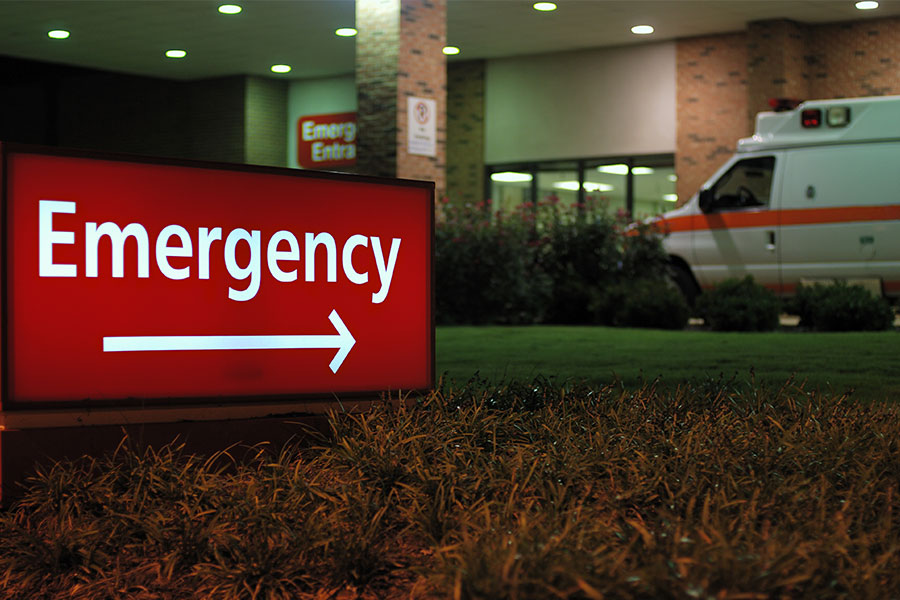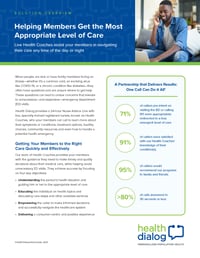An average trip to the emergency department (ED) carries a price tag of $1,389, with a wait time of over two hours.[1], [2] However, according to the Centers for Disease Control and Prevention (CDC), only 12.4% of visits to the ED result in hospital admissions, demonstrating that many of these costly and timely trips may not be necessary.[3]
Treating common, non-emergency conditions in an emergency department costs about 12 times more than a physician’s office and 10 times more than an urgent care center.[4] Helping members understand when—and if—a visit to the ED is necessary is a critical step in reducing healthcare waste. A 24/7 nurse line, like Health Dialog’s Nurse Advice Line, can help callers evaluate their symptoms and determine the most appropriate level of care. In fact, 70% of callers pre-intent on visiting the ED when they called our Nurse Advice Line were redirected to a more appropriate level of care.
Determining When an ED Visit is Needed
There are a variety of reasons why people might think they need to visit the emergency department, such as not being sure if their symptoms are life-threatening. For instance, dizziness may feel alarming and cause someone to go to the ED seeking immediate treatment. However, while dizziness coupled with other factors may require immediate medical treatment, many causes, such as dehydration, can easily be addressed with self-care. People often visit the ED when they are unsure what to do. Our Health Coaches are specially trained to listen to members’ concerns while conducting an in-depth symptom check to evaluate their unique situations and help them determine the appropriate level of care to seek—whether they actually need the ED or can address their symptoms at home.
Some people can’t, or don’t want to, wait to be seen by their primary care provider (PCP). On average, Americans are waiting nearly a month for a new-patient PCP appointment and anywhere from a few days to a few weeks for existing patients.[2], [5] Additionally, with busy schedules, some people find it challenging to take time off to visit the doctor. For others, transportation may be an issue. An emergency department may be closer in proximity and easier to get to than a physician’s office. In these scenarios, a cost-saving option is a 24-hour nurse line where the person’s symptoms can be evaluated and appropriate care plans determined.
Making Decisions That Matter
Following are two real-life scenarios, one where a caller to our Nurse Advice Line was unnecessarily pre-intent on visiting the emergency department and one where the caller did need immediate medical attention.
Caller Unnecessarily Pre-Intent on Visiting the ED Redirected to Less Emergent Care
A female caller in her 50s reported a persistent cough and moderate pain in her ribs. She wanted to go to the ED, but was fearful due to COVID-19. After conducting a symptom check, the nurse advised that the woman didn’t need to seek care in the ED, but rather in a provider’s office. The nurse also reviewed home care and symptoms to watch for that would indicate the need to seek immediate professional care. Calling our Nurse Advice Line saved the caller an un-needed trip to the emergency department and gave her the health information she needed to better evaluate her symptoms in the future.
Caller in Need of Immediate Medical Attention
A 67-year-old female called our Nurse Advice Line because she was experiencing dizziness and feeling lightheaded. The caller stated that the severity of the dizziness was making her concerned that she would fall and she was unsure what to do. This particular patient had a history of hypertension and prediabetes. Upon conducting a symptom check, our nurse discovered there had been a recent change in the woman’s blood pressure medication and her latest reading was 175/96 (average for a woman her age is 139/68). After completing the symptom check and assessing the severity of the caller’s symptoms, the nurse suggested that it would be best for the caller to seek care in the ED.
A few days later, the nurse followed up with the caller to see how she was doing after visiting the ED. The patient reported that her medications were evaluated and adjusted and that she had follow-up appointments scheduled with a cardiologist, ear, nose and throat doctor, and primary care provider. The nurse also discussed with the patient what she should be monitoring in the near future in regards to her symptoms. In this case, a trip to the emergency department was required due to the potential of a cardiac event. Had this caller not sought treatment, she may have suffered more severe health complications.
Giving patients access to a 24/7 nurse line can help curb unnecessary ED visits or, more importantly, save lives. In situations where callers may not know where to seek care, a trusted nurse health coach on the other end of the line can help callers make the best decisions for their medical needs, and their wallets.
[1] Alltucker, K (2019). ‘Really astonishing’: Average cost of hospital ER visit surges 176% in a decade, report says. USA Today. June 4, 2019.
[2] RelyMD. Average Wait Times to See a Doctor. https://relymd.com/blog-infographic-average-wait-times-to-see-a-doctor/.
[3] Centers for Disease Control and Prevention. Emergency Department Visits. https://www.cdc.gov/nchs/fastats/emergency-department.htm.
[4] Lagasse, J (2019). Diverting avoidable emergency department visits could save healthcare $32 billion annually. Healthcare Finance. https://www.healthcarefinancenews.com/news/diverting-avoidable-emergency-department-visits-could-save-healthcare-32-billion-annually.
[5] Smith, K (2017). Emergency department overuse: routing low-acuity visits away from the ED with virtual care. Becker’s Health IT. November 21, 2017. https://www.beckershospitalreview.com/healthcare-information-technology/emergency-department-overuse-routing-low-acuity-visits-away-from-the-ed-with-virtual-care.html.


